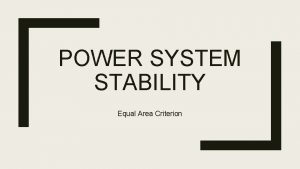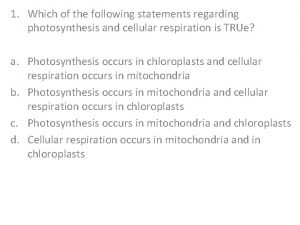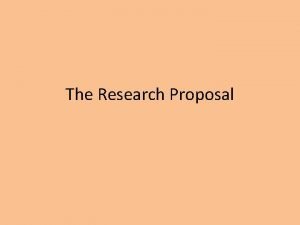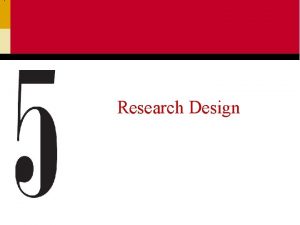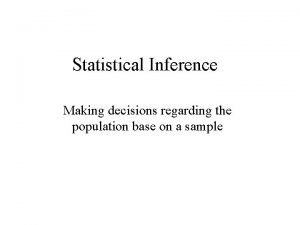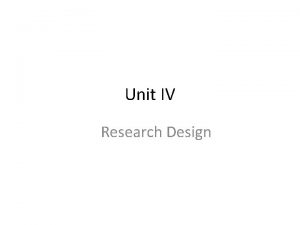Research Design Decisions regarding what where when how




























- Slides: 28

Research Design Decisions regarding what, where, when, how much It constitutes the blueprint for the collection and analysis of data

Meaning Research Design • A research design is the arrangement of conditions for collection and analysis of data in a manner that aims to combine relevance to the research purpose with economy in procedure. • First, it is the plan that specifies the sources and types of information relevant to the research questions.

• Second, it is strategy or blueprint specifying which approach will be used for gathering and analysing the data. • Finally, since most business research studies have time and economic constraint, both time and cost budget are typically included.

• The designing decisions happen to be in respect of: – – – – – (i) What is the study about? (ii) Why is the study being made? (iii) Where will the study be carried out? (iv) What type of data is required? (v) Where can the required data be found? (vi) What periods of time will the study include? (vii) What will be the sample design? (viii) What techniques of data collection will be used? (ix) How will the data be analyzed? (x) In what style will the report be prepared?

• A research design must atleast contain • A)A clear statement of problem • B)Procedure and technique used for gathering the information • C)Population to be studied • D) Methods to be used for processing and analysis of data

• The Sampling Design – which deals with the method of selecting items to be observed for the given study • The Observational Design – which relates to the conditions under which the observations are to be made • The Statistical Design – which concerns with the question of how many items are to be observed and how the information and data gathered are to be analyzed • The Operational Design – which deals with the techniques by which the procedures specified in the sampling, statistical and observational designs can be carried out

Need research design • It is needed because it facilitates the smooth sailing of the various research operations, thereby making research as efficient as possible yielding maximum information with minimal expenditure of efforts, time and money. Research design stands for advance planning of the methods to be adapted for collecting the relevant data and technique to be used in their analysis keeping in view the objective of the research and the availability of staff, time and money.

• A research design usually involves he consideration of the following factors: • The mean for obtaining information. • The availability and skills of the researcher and his staff, if nay. • The objective of the problem to be studied. • The nature of the problem to be studied. • The availability of time and money for the research work.

Research Design – Important Concepts • Dependent & Independent Variables A concept which can take on different quantitative values is called a variable. Ex: weight, height, income etc. , are examples of a variable • Quualitative phenomena (the attribute) are also quantified on the basis of the presence or absence of the concerning attribute

• If one variable depends upon or is a consequence of the other variable --- a dependent variable, • the variable that is antecedent to the dependent variable --- an independent variable. • . Dependent & Independent Variables Ex: if we say that height depends upon age, then height is the D V and age is the IV. Further, if height also depends upon the individual’s sex – then, height is the DV and age and sex are the IVs

Extraneous Variable • I V s that are not related to the purpose of the study, but may affect the D V are termed as Extraneous V ariable (E V ) Ex: suppose the researcher wants to test the hypothesis that there is a relationship between children’s gains in social studies achievement and their self-concept. Here, self-concept is an I V and social studies achievement is a D V. Intelligence may as well affect the social studies achievement, but since it is not related to the purpose of the study, it will be termed as an E V

• Control One important characteristic of a good research design is to minimize the influence or effect of the E V. The term “Control” is used when we design the study minimizing the effects of extraneous variables. • Confounded Relationship When the D V is not free from the influence of the E V s , the relationship between D V and I V is said to be confounded by the E V

• Research Hypothesis When a prediction or a hypothesized relationship is to be tested by scientific methods, it is termed as a Research. Hypothesis The Research-Hypothesis is a predictive statement that relates an I V to a D V • Experimental and Non-Experimental Hypothesis testing research When the I V is manipulated it is an experimental design Research • In which the I V is not manipulated is called Nonexperimental hypothesis-testing research

• Ex: a researcher wants to study whether intelligence affects reading ability for a group of students and for this purpose he randomly selects 5 0 students and tests their intelligence and reading ability by calculating the co-efficient of correlation between the two sets of scores – this is an example of nonexperimental hypothesis testing, because the I V intelligence is not manipulated

• But now , suppose that the researcher randomly selects 5 0 students from a group of students who are to take a course in statistics and then divides them into two groups by randomly assigning 2 5 to group A, the common program, and 2 5 to group B, the special program. At the end of the course, he administers a test to each group in order to judge the effectiveness of the training program on the students’ performance. This is an example of experimental hypothesis testing because the I V (the type of training program) is manipulated.

TREATMENTS – The two treatments are the usual studies programme and the special studies programme • For example, if we want to determine through an experiment the comparative impact of three varieties of fertilizers on the yield of wheat, in that case three varieties of fertilizers will be treated as three treatments.

• E X P E RI M E N T – Examining the truth of a statistical hypothesis, relating to some research problem, is known as an experiment. • For example, an experiment to examine the usefulness of a certain newly developed drug – Experiments can be of two types viz. , absolute experiment and comparative experiment. • If we want to determine the impact of a fertilizer on the yield of a crop, it is a case of absolute experiment; • but if we want to determine the impact of one fertilizer as compared to the impact of some other fertilizer, our experiment then will be termed as a comparative experiment.

Types Of Research Design • • Design of Exploratory Studies: : The purpose of exploratory studies is to achieve new insight into phenomenon. The major emphasis in those studies is discovery of new insight or ideas. Flexible research design is appropriate for such studies Exploratory studies are more appropriate in the case of problem about which little knowledge is available. An exploratory research will be effective and turn out to be fruitful if the following three methods are adapted before the initiation: (i) Survey of Concerning Literature: This is a fruitful method of formulating precisely the research problem and formulating the hypothesis Study of hypothesis already stated and their evaluation. Bibliograhical survey of studies already made in one; s area of interest (ii) Experience Survey: The survey of people who have had practical experience with the problem to be studied. (iii) Analysis of Insight-stimulating cases: The analysis of insight-stimulating is suitable in the area where there is little experience to serve as a guide. This method consists of intensive study of selected instances of the phenomenon in which one in interested. For this purpose the existing records if any may be examined

Design in case Diagnostic and descriptive research Studies • Descriptive studies aim at portraying accurately the characteristics of a particular group or situation. One may take a descriptive study about the work in factory, their age distribution, their community-wise distribution, their educational level, the state of their physical health and so forth. . research design should be rigid not flexible

• Procedure: A descriptive study involves the following steps: • (a) Formulating the objectives of study: It is the first step to specify the objectives with sufficient precision to ensure that the data collected are relevant. If this is not done carefully, the study may not provide the desired information. (What the study is about and why it is being made) • (b) Designing the methods of data collection: The technique for collecting the information must be devised. Several methods such as observation, questionnaire, interviewing, examination of the records etc, with their merits and demerits, are available for the purpose and the researcher may use one or more of these methods. (What technique of gathering data will be adopted) • (c) Defining the population and selecting a sample: In most of the descriptive studies the researcher takes out samples and then wishes to make statements about the population on the basis of the sample analysis. Researcher has to select a sample design to be used in his study. Usually one or more forms of probability sampling or random sampling are used. (How much material will be needed)

• (d) Collection of Data: To obtain data free from errors, checks may be set up to ensure that the data collecting staff perform their duty honestly and without prejudice. (Where can be the required data be found and with what time period should the data be related) • (e) Processing and Analaysing of data: The data collected must be processed analyzed. This includes steps like coding the interview replies, observation, etc, tabulating the data and performing several statistical computations. • (f) Reporting the Findings: This is the task of communicating the findings to others and researchers must do it in an efficient manner. The layout of the reports needs to be well planned so that all things relating to research studies may be well presented in simple and effective style.

• (c) Design of Diagnostic Studies: A diagnostic study is the solution of a specific problem by the researcher of the relevant variables that are associated with it in varying degrees. A diagnostic study, for example, may aim at discovering or analyzing the specific problem of the farmers, college teachers, career women or pensioners. While discovering or analyzing the specific problems or needs of these categories of people, the diagnostic study aims to identify the relevant variables associated with the problem or needs. It involves the same steps as the descriptive studies involve.


Hypothesis-testing research studies – known as experimental studies or design of experiments • tests the hypotheses of causal relationships between variables. • Prof R. A Fisher name is associated with experimental designs. • Experimental designs has its origin in agricultural research

– Three basic principles of experimental designs • (1) the Principle of Replication; • (2) the Principle of Randomization; • (3) Principle of Local Control.

The Principle of Replication – the experiment should be repeated more than once – The statistical accuracy of the experiments is increased • For example, we are to examine the effect of two varities of rice. for this purpose we may divide the field in to two parts and grow one variety in one part and other variety in other part. we then compare the yields of two parts and draw the conclusion. But according to principle of replication then we first divide the field into several parts and grow one variety in half of theses parts and other variety in remaining parts. We can then collect the data of two yields and draw conclusion by comparing the same

The Principle of Randomization • This principle provides protection against the effect of extraneous factors by randomization. • This principle indicates that we should design or plan the experiment in such a way that the variation caused by extraneous factors can all be combined under the general heading chance

• For instance, if we grow one variety of rice, say, in the first half of the parts of a field and the other variety is grown in the other half, then it is just possible that the soil fertility may be different in the first half in comparison to the other half. If this is so, our results would not be realistic. • In such a situation, we may assign the variety of rice to be grown in different parts of the field on the basis of some random sampling technique i. e. , we may apply randomization principle and protect ourselves against the effects of the extraneous factors.
 Poster making meaning
Poster making meaning Screening decisions and preference decisions
Screening decisions and preference decisions Methodology vs research design
Methodology vs research design Ethical considerations examples
Ethical considerations examples Methodology errors
Methodology errors Characteristics of exploratory research
Characteristics of exploratory research Qualitative approach
Qualitative approach Supply chain network design decisions include
Supply chain network design decisions include Supply chain network design decisions
Supply chain network design decisions Channel management decisions
Channel management decisions Facility network design logistics
Facility network design logistics Channel design paradigm
Channel design paradigm Channel design definition
Channel design definition Touching spirit bear questions
Touching spirit bear questions Hearsay legal
Hearsay legal Ckt motor perlis
Ckt motor perlis Letter for seeking information
Letter for seeking information Which of the following statements regarding
Which of the following statements regarding 29 cfr 1910 ppe
29 cfr 1910 ppe Which is the false statement regarding rdas
Which is the false statement regarding rdas Steady precipitation preceding a front is an indication of
Steady precipitation preceding a front is an indication of The equal area criteria of stability is used for
The equal area criteria of stability is used for Orthographic projection definition
Orthographic projection definition Difference between absolute and contingent contract
Difference between absolute and contingent contract Which of the following statements regarding the
Which of the following statements regarding the Internal check regarding wages
Internal check regarding wages Answer the questions below regarding the heating of a house
Answer the questions below regarding the heating of a house What policy did the qing adopt regarding foreign trade?
What policy did the qing adopt regarding foreign trade? Research report vs research proposal
Research report vs research proposal





















